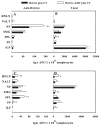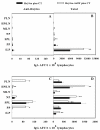Adenovirus F protein as a delivery vehicle for botulinum B
- PMID: 20609248
- PMCID: PMC2912244
- DOI: 10.1186/1471-2172-11-36
Adenovirus F protein as a delivery vehicle for botulinum B
Abstract
Background: Immunization with recombinant carboxyl-terminal domain of the heavy chain (Hc domain) of botulinum neurotoxin (BoNT) stimulates protective immunity against native BoNT challenge. Most studies developing a botulism vaccine have focused on the whole Hc; however, since the principal protective epitopes are located within beta-trefoil domain (Hcbetatre), we hypothesize that immunization with the Hcbetatre domain is sufficient to confer protective immunity. In addition, enhancing its uptake subsequent to nasal delivery prompted development of an alternative vaccine strategy, and we hypothesize that the addition of targeting moiety adenovirus 2 fiber protein (Ad2F) may enhance such uptake during vaccination.
Results: The Hcbetatre serotype B immunogen was genetically fused to Ad2F (Hcbetatre/B-Ad2F), and its immunogenicity was tested in mice. In combination with the mucosal adjuvant, cholera toxin (CT), enhanced mucosal IgA and serum IgG Ab titers were induced by nasal Hcbetatre-Ad2F relative to Hcbetatre alone; however, similar Ab titers were obtained upon intramuscular immunization. These BoNT/B-specific Abs induced by nasal immunization were generally supported in large part by Th2 cells, as opposed to Hcbetatre-immunized mice that showed more mixed Th1 and Th2 cells. Using a mouse neutralization assay, sera from animals immunized with Hcbetatre and Hcbetatre-Ad2F protected mice against 2.0 LD50.
Conclusion: These results demonstrate that Hcbetatre-based immunogens are highly immunogenic, especially when genetically fused to Ad2F, and Ad2F can be exploited as a vaccine delivery platform to the mucosa.
Figures






Similar articles
-
Sublingual immunization with adenovirus F protein-based vaccines stimulates protective immunity against botulinum neurotoxin A intoxication.Int Immunol. 2012 Feb;24(2):117-28. doi: 10.1093/intimm/dxr106. Epub 2011 Dec 29. Int Immunol. 2012. PMID: 22207133 Free PMC article.
-
Mucosal vaccine targeting improves onset of mucosal and systemic immunity to botulinum neurotoxin A.J Immunol. 2006 Oct 15;177(8):5524-32. doi: 10.4049/jimmunol.177.8.5524. J Immunol. 2006. PMID: 17015739
-
Mucosal targeting of a BoNT/A subunit vaccine adjuvanted with a mast cell activator enhances induction of BoNT/A neutralizing antibodies in rabbits.PLoS One. 2011 Jan 27;6(1):e16532. doi: 10.1371/journal.pone.0016532. PLoS One. 2011. PMID: 21304600 Free PMC article.
-
Structure, activity, and immune (T and B cell) recognition of botulinum neurotoxins.Crit Rev Immunol. 1999;19(3):219-60. Crit Rev Immunol. 1999. PMID: 10422600 Review.
-
Mode of action of botulinum neurotoxins: current vaccination strategies and molecular immune recognition.Crit Rev Immunol. 2010;30(2):167-87. doi: 10.1615/critrevimmunol.v30.i2.50. Crit Rev Immunol. 2010. PMID: 20370628 Review.
Cited by
-
Sublingual immunization with adenovirus F protein-based vaccines stimulates protective immunity against botulinum neurotoxin A intoxication.Int Immunol. 2012 Feb;24(2):117-28. doi: 10.1093/intimm/dxr106. Epub 2011 Dec 29. Int Immunol. 2012. PMID: 22207133 Free PMC article.
-
Enhancing toxin-based vaccines against botulism.Vaccine. 2018 Feb 1;36(6):827-832. doi: 10.1016/j.vaccine.2017.12.064. Epub 2018 Jan 4. Vaccine. 2018. PMID: 29307477 Free PMC article.
-
Optimized Mucosal Modified Vaccinia Virus Ankara Prime/Soluble gp120 Boost HIV Vaccination Regimen Induces Antibody Responses Similar to Those of an Intramuscular Regimen.J Virol. 2019 Jun 28;93(14):e00475-19. doi: 10.1128/JVI.00475-19. Print 2019 Jul 15. J Virol. 2019. PMID: 31068425 Free PMC article.
References
-
- Hatheway C. In: Infectious Diseases. Bartlett JG, Blacklow NR, editor. Orlando: WB Saunders; 1991. Clostridium botulinum; pp. 583–1586.
Publication types
MeSH terms
Substances
Grants and funding
LinkOut - more resources
Full Text Sources
Other Literature Sources
Medical
Miscellaneous

